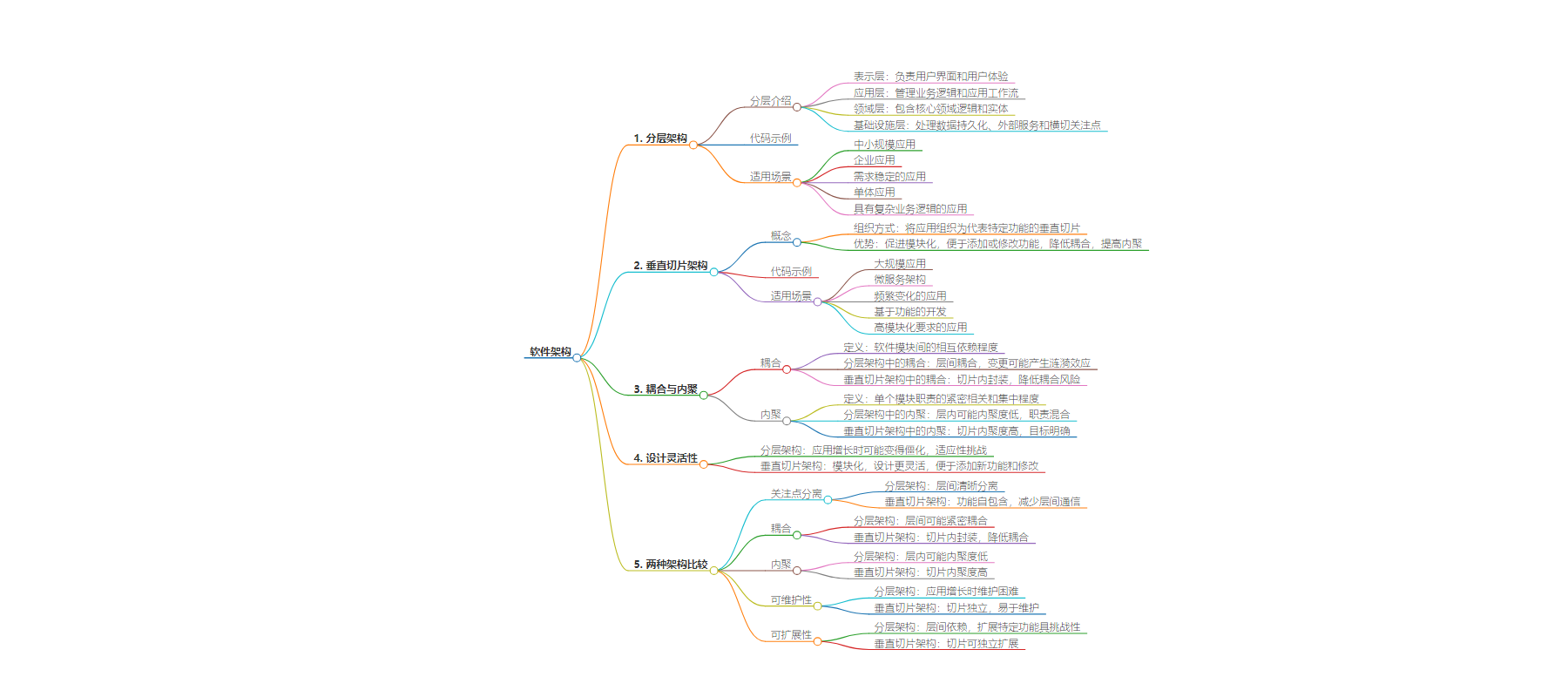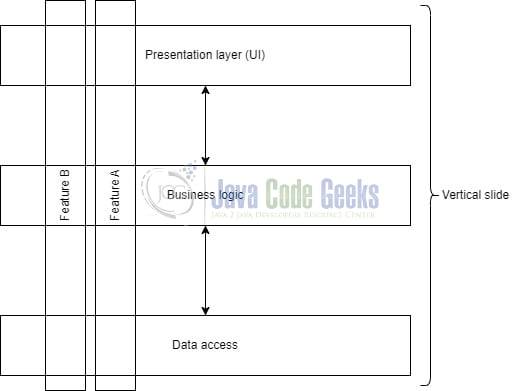包阅导读总结
1.
关键词:软件架构、垂直切片架构、分层架构、耦合、内聚
2.
总结:本文探讨了软件架构中的分层架构和垂直切片架构,分析了它们的特点、适用场景、代码示例,比较了两者在关注点分离、耦合、内聚、可维护性和可扩展性方面的差异,指出垂直切片架构在某些方面更具优势。
3.
主要内容:
– 分层架构
– 常见架构模式,将应用分为展示层、应用层、领域层和基础设施层
– 适用中小规模应用、企业应用等,但可能导致层间紧耦合
– 代码示例展示用户注册功能的分层实现
– 垂直切片架构
– 按功能组织应用为垂直切片,各切片包含所需组件
– 适用于大规模、频繁变化等应用,耦合度低、内聚度高
– 代码示例展示用户注册功能的垂直切片实现
– 耦合和内聚
– 耦合指模块间依赖程度,分层架构层间易耦合,垂直切片架构切片间耦合低
– 内聚指模块职责相关性,分层架构层内可能内聚低,垂直切片架构切片内聚高
– 设计灵活性
– 分层架构随应用增长适应性差,垂直切片架构模块化更灵活
– 两种架构比较
– 关注点分离:分层按层,垂直切片按功能
– 耦合:分层易层间耦合,垂直切片切片耦合低
– 内聚:分层层内聚可能低,垂直切片切片内聚高
– 维护性:分层维护难,垂直切片易维护
– 可扩展性:分层挑战大,垂直切片可独立扩展切片
思维导图:
文章地址:https://www.javacodegeeks.com/vertical-slice-architecture.html
文章来源:javacodegeeks.com
作者:Yatin Batra
发布时间:2024/8/19 8:33
语言:英文
总字数:1568字
预计阅读时间:7分钟
评分:85分
标签:软件架构,软件开发,架构比较,模块化,可维护性
以下为原文内容
本内容来源于用户推荐转载,旨在分享知识与观点,如有侵权请联系删除 联系邮箱 media@ilingban.com
In the world of software architecture, different approaches have been developed to manage complexity, maintainability, and scalability. Two prominent architectures are the Layered Architecture and the Vertical Slice Architecture. This article explores these architectures, with a particular focus on Vertical Slice Architecture. Let us delve to understand the concepts of coupling and cohesion, and how these architectures impact design flexibility.
1. Layered Architecture
Layered Architecture is one of the most common architectural patterns used in software development. It organizes the application into layers, each responsible for a specific concern. Typically, these layers include:
- Presentation Layer: Responsible for handling user interface and user experience.
- Application Layer: Manages business logic and application workflows.
- Domain Layer: Contains core domain logic and entities.
- Infrastructure Layer: Handles data persistence, external services, and cross-cutting concerns.
This structure promotes separation of concerns, making the application easier to maintain and test. However, it can also lead to tight coupling between layers, especially as the application grows.
1.1 Code Example: Layered Architecture
Here’s a simple example of how a user registration feature might be implemented in a Layered Architecture:
// Presentation Layer (Controller)@PostMapping("/register")public ResponseEntity<String> registerUser(@RequestBody UserDto userDto) { userService.registerUser(userDto); return ResponseEntity.ok("User registered successfully");}// Application Layer (Service)public void registerUser(UserDto userDto) { User user = userMapper.toEntity(userDto); userRepository.save(user);}// Domain Layer (Entity)@Entitypublic class User { @Id @GeneratedValue(strategy = GenerationType.IDENTITY) private Long id; private String username; private String password; // getters and setters}// Infrastructure Layer (Repository)@Repositorypublic interface UserRepository extends JpaRepository<User, Long> {}
1.2 Layered Architecture Use Cases
- Small to Medium-Sized Applications: Ideal for applications where the scope is limited, and the complexity can be managed through clear separation of concerns.
- Enterprise Applications: Suitable for enterprise-level applications with well-defined layers, such as ERP systems, where different teams manage different layers.
- Applications with Stable Requirements: Works well when the requirements are stable, and there are fewer changes anticipated in the system.
- Monolithic Applications: Commonly used in monolithic applications where all features are tightly integrated and managed in a single codebase.
- Applications with Complex Business Logic: Useful when the application has complex business rules that are best managed within a centralized business logic layer.
2. The Vertical Slice Architecture
Vertical Slice Architecture takes a different approach by organizing the application into vertical slices, each representing a specific feature or functionality. Instead of separating the application into horizontal layers, Vertical Slice Architecture groups all necessary components for a feature, such as the user interface, business logic, and data access, into a single module.
This architecture promotes modularity, making it easier to add or modify features without impacting other parts of the application. Each slice is self-contained, which reduces coupling between different parts of the application and increases cohesion within a slice.

2.1 Code Example: Vertical Slice Architecture
In Vertical Slice Architecture, the same user registration feature would be implemented as a self-contained slice:
// User Registration Slice (Controller + Service + Repository in one module)@PostMapping("/register")public ResponseEntity<String> registerUser(@RequestBody UserDto userDto) { User user = new User(userDto.getUsername(), userDto.getPassword()); userRepository.save(user); return ResponseEntity.ok("User registered successfully");}@Entitypublic class User { @Id @GeneratedValue(strategy = GenerationType.IDENTITY) private Long id; private String username; private String password; // Constructor, getters, and setters}@Repositorypublic interface UserRepository extends JpaRepository<User, Long> {}
2.2 Vertical Slice Architecture Use Cases
- Large-Scale Applications: Ideal for large, complex applications where features can be developed and deployed independently.
- Microservices Architecture: Aligns well with microservices, where each slice can be developed, deployed, and scaled as a separate service.
- Applications with Frequent Changes: Suitable for applications that require frequent updates or have evolving requirements, as slices can be modified without affecting others.
- Feature-Based Development: Best for applications where development is organized around distinct features, allowing teams to focus on delivering specific functionality end-to-end.
- High Modularity Requirements: Useful when the application demands high modularity, allowing individual slices to be developed, tested, and deployed independently.
3. Coupling and Cohesion
Coupling and cohesion are two fundamental principles in software design that greatly influence the maintainability, scalability, and robustness of an application.
3.1 Coupling
Coupling refers to the degree of interdependence between software modules. In highly coupled systems, changes in one module are likely to affect other modules, making the system more fragile and harder to maintain. Low coupling, on the other hand, means that modules are more independent, allowing changes to be made to one module without significant impact on others.
In Layered Architecture:
- The coupling tends to occur between layers, especially if business logic is spread across multiple layers. For example, a change in the data access layer might necessitate changes in the business logic or presentation layers.
- This inter-layer dependency can lead to ripple effects when changes are required, making the architecture harder to adapt as the system grows.
In Vertical Slice Architecture:
- Coupling is minimized by encapsulating all necessary components for a feature within a single slice. Each slice operates independently, reducing the risk of changes in one slice affecting others.
- This low coupling promotes more stable and maintainable systems, as features can evolve independently without causing unintended side effects in other parts of the application.
3.2 Cohesion
Cohesion refers to how closely related and focused the responsibilities of a single module are. High cohesion within a module means that all parts of the module work together towards a single purpose, making the code more understandable, maintainable, and reusable.
In Layered Architecture:
- Cohesion can be low within layers, especially when the same layer contains logic for multiple features. For instance, the business logic layer might have various methods and classes that serve different parts of the application, leading to a mix of responsibilities.
- This lack of focus within layers can make the system harder to understand and maintain, as developers need to navigate through unrelated code to make changes or fix issues.
In Vertical Slice Architecture:
- Cohesion is high because each slice contains all the components needed for a single feature or functionality. The code within each slice is tightly focused on achieving a specific goal, making it easier to understand and work with.
- This high cohesion leads to more maintainable code, as developers can easily locate the relevant code for a feature and make changes without affecting unrelated parts of the application.
4. Design Flexibility
Design flexibility refers to the architecture’s ability to adapt to changes in requirements, technologies, or business needs. Flexibility is a critical factor in determining how future-proof an architecture is, as it directly impacts the ease with which new features can be added, existing features can be modified, or the system can be scaled.
Layered Architecture, while promoting separation of concerns, can become rigid and challenging to adapt as the application grows.
Vertical Slice Architecture, with its modular approach, offers greater design flexibility. Since each slice is self-contained, new features can be added, and existing features can be modified without affecting other parts of the application. This modularity allows for easier experimentation, faster iterations, and smoother scaling of the application.
5. Comparison Between Layered and Vertical Slice Architectures
| Aspect | Layered Architecture | Vertical Slice Architecture |
|---|---|---|
| Separation of Concerns | Promotes clear separation between layers (e.g., UI, business logic, data access). Easier to manage when dealing with distinct concerns. | Focuses on separating features instead of layers. Each slice is self-contained with all necessary components, reducing the need for inter-layer communication. |
| Coupling | Can lead to tight coupling between layers, making it harder to change one layer without affecting others. | Reduces coupling by encapsulating all relevant components within a single slice. Changes in one slice usually don’t affect others. |
| Cohesion | May result in lower cohesion within layers, especially when different features share the same layer. | Promotes high cohesion as each slice contains only the components needed for a specific feature, making it more focused. |
| Maintainability | Can be difficult to maintain as the application grows, especially with tightly coupled layers and shared responsibilities. | Easier to maintain since each slice is independent, making it simpler to manage changes or updates. |
| Scalability | Scalability can be challenging due to interdependencies between layers. Scaling specific features may require changes across multiple layers. | Highly scalable, as individual slices can be scaled independently without impacting other slices. |
| Testing | Testing may require mocking or stubbing layers, which can add complexity to the testing process. | Testing is more straightforward, as each slice is self-contained, reducing the need for extensive mocking and stubbing. |
| Flexibility | Less flexible when dealing with changes, as modifications in one layer may necessitate changes in others. | Offers greater flexibility, as changes in one slice typically don’t affect other slices. |
| Learning Curve | Lower learning curve for those familiar with traditional architectures, but can become complex as the application grows. | Higher initial learning curve, especially for developers new to this approach, but pays off in terms of maintainability and flexibility. |
| Development Speed | May be slower in large applications due to the need to navigate and update multiple layers. | Can lead to faster development, especially for adding new features, as each slice can be developed independently. |
6. Conclusion
Both Layered and Vertical Slice Architectures have their strengths and challenges. Layered Architecture is well-suited for small to medium-sized applications where separation of concerns is critical. However, as applications grow in complexity, Vertical Slice Architecture offers a more flexible and modular approach, with improved cohesion and reduced coupling.
Understanding these architectures and their implications on coupling, cohesion, and design flexibility can help you make informed decisions when designing your software systems.
